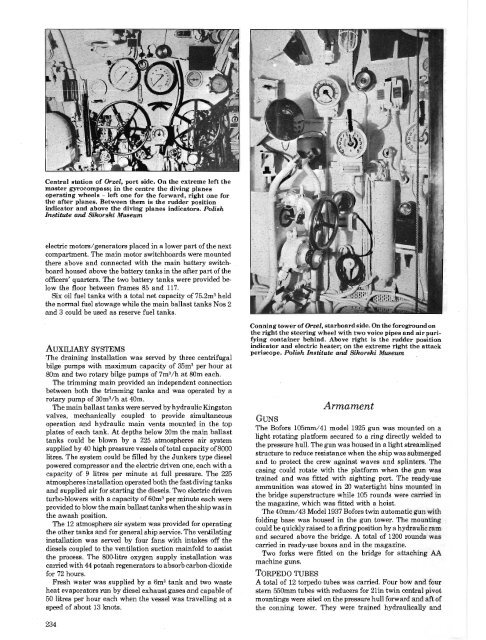You also want an ePaper? Increase the reach of your titles
YUMPU automatically turns print PDFs into web optimized ePapers that Google loves.
Central station of Orzel, port side. On the extrerne left the<br />
master gJrrocompass; in the centre the diving planes<br />
operating wheels - left one for the forward, right one for<br />
the after planes. Between them is the rudder position<br />
indicator and above the diving planes indicatorc. Polish<br />
Institute and. Sikorski Museum<br />
electric motors/generators placed in a lower part of the next<br />
compartment. The main motor switchboards were mounted<br />
there above and connected with the main battery switchboard<br />
housed above the battery tanks in the after part ofthe<br />
officers' quarters. The two battery tanks were provided below<br />
the floor between frames 85 and 117.<br />
Six oil fuel tanks with a total net capacity of 75.2m3 held<br />
the normal fuel stowage while the main ballast tanks Nos 2<br />
and 3 could be used as reserve fuel tanks.<br />
Auxnnnv sYsrEMs<br />
The draining installation was served by three centrifugal<br />
bilge pumps with maximum capacity of 35m3 per hour at<br />
80m and two rotary bilge pumps of 7m3/h at 80m each.<br />
The trimming main provided an independent connection<br />
between both the trimming tanks and was operated by a<br />
rotary pump of 30m3,/h at 40m.<br />
The main ballast tanks were served byhydraulic Kingston<br />
valves, mechanically coupled to provide simultaneous<br />
operation and hydraulic main vents mounted in the top<br />
plates of each tank. At depths below 20m the main ballast<br />
tanks could be blown by a 225 atmospheres air system<br />
supplied by 40 high pressure vessels oftotal capacity of8000<br />
litres. The system could be filled by the Junkers type diesel<br />
powered compressor and the electric driven one, each with a<br />
capacity of 9 litres per minute at full pressure. The 225<br />
atmospheres installation operated both the fast diving tanks<br />
and supplied air for starting the diesels. TWo electric driven<br />
turbo-blowers with a capacity of 60ma per minute each were<br />
provided to blow the main ballasttanks when the ship was in<br />
the awash position.<br />
The 12 atmosphere air system was provided for operating<br />
the other tanks and for general ship service. The ver*ilating<br />
installation was servd by four fans with intakes off the<br />
diesels coupled to the ventilation suction mainfold to assist<br />
the process. The 800-litre oxygen supply installation was<br />
carried with <strong>44</strong> potash regenerators to absorb carbon-dioxide<br />
for 72 hours.<br />
Fresh water was supplied by a 6m3 tank and two waste<br />
heat evaporators run by diesel exhaust gases and capable of<br />
50 litres per hour each when the vessel was travelling at a<br />
speed of about 13 Lnots.<br />
Conning tower of Orzel, etarboard side. On the foreground on<br />
the right the steering wheel with two voice pipes and airpurifying<br />
container behind. Above right is the rudder position<br />
indicator and electric heater; on the extreme right the attack<br />
periscope, Poliah Institute and. Sikoraki Museurn<br />
Armament<br />
GuNs<br />
The Bofors 105mm,241 model 1925 gun was mounted on a<br />
light rotating platform secured to a ring directly welded to<br />
the pressure hull. The gun was housed in a light streamlined<br />
structure to reduce resistance when the ship was submerged<br />
and to protect the crew against waves and splinters. The<br />
casing could rotate with the platform when the gun was<br />
trained and was fitted with sighting port. The ready-use<br />
ammunition was stowed in 20 watertight bins mounted in<br />
the bridge superstructure while 105 rounds were carried in<br />
the magazine, which was fitted with a hoist.<br />
The 40mm,243 Model 1937 Bofors twin automatic gun with<br />
folding base was housed in the gun tower. The mounting<br />
could be quickly raised to afiring position by a hydraulic ram<br />
and secured above the bridge. A total of 1200 rounds was<br />
canied in ready-use boxes and in the magazine.<br />
TWo forks were fitted on the bridge for attaching<br />
machine guns.<br />
Tonpnoo rUBES<br />
A total of 12 torpedo tubes was carried. Four bow and four<br />
stern 550mm tubes with reducers for 21in twin central pivot<br />
mountings were sited on the pressure hull forward and aft of<br />
the conning tower. They were trained hydraulically and<br />
AA<br />
234



